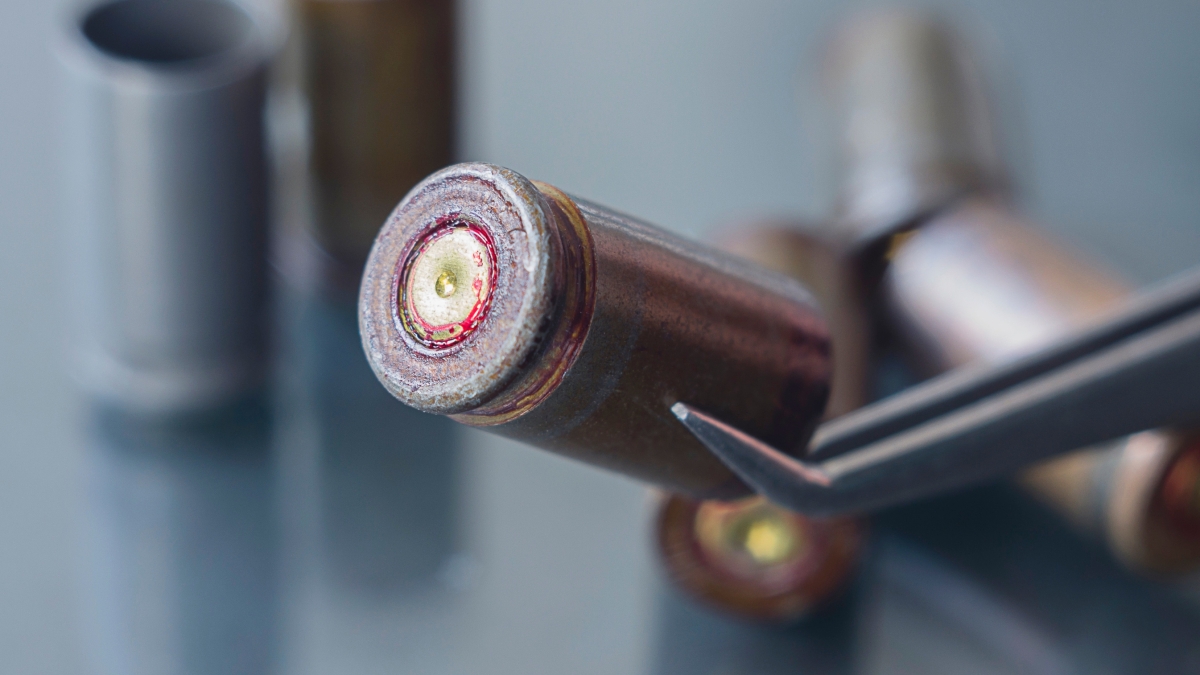ASU study sheds new light on inconclusive gun evidence

When bullets are fired from a criminal's gun, ejected cartridge cases can scatter around the shooter. And unless that person is fastidious enough to gather those cases, they serve as a valuable tool in solving a crime.
Microscopic markings on ejected cartridge cases that match the gun used in a crime can usually provide enough conclusive evidence to land a suspect in the slammer.
But what happens if the results are inconclusive?
In court cases, inconclusive decisions on cartridge-case comparisons can be a contributing factor in putting innocent people behind bars, and the lack of rigorous research in the field of forensic ballistics can keep them there.
A new study by Arizona State University researchers may help change that.
The study, which was published in the Proceedings of the National Academy of Sciences, found that 85% of cartridge cases that were judged inconclusive by forensic firearm examiners were actually fired by two different guns. In an actual crime scene investigation, that would mean that the cartridge cases did not match the gun in question.
“The study was the first to closely examine the usefulness of inconclusive decisions in helping to clear the innocent of wrongdoing,” said Max Guyll, one of the researchers behind the study who is an associate professor of psychology in ASU’s new School of Interdisciplinary Forensics.
“What we found was that inconclusive decisions were predictive of, or related to, cartridges that are fired from different guns,” Guyll said.
Stephanie Madon
According to Stephanie Madon, the principal investigator on the study and a psychology professor in the School of Interdisciplinary Forensics, some prior studies either ignored inconclusive decisions when examining firearm identification or inappropriately treated inconclusive decisions as correct decisions.
“What made our study unique is that we focused on the exculpatory probative value of inconclusive decisions,” Madon said.
Coming to an inconclusive decision
When a bullet is fired from a firearm, it creates dents, tiny grooves or tool markings that make up a fingerprint of sorts on the cartridge case. If the markings on the case match those on a gun, it is considered an “identification.”
In some cases, when forensic examiners cannot definitely match a cartridge case and the gun being investigated for the crime, forensic examiners will use the term “inconclusive.”
According to Guyll, there are many reasons for an inconclusive result.
“They (the cartridge cases) may come from different guns or they may come from the same gun, but marked differently because a suspect tampered with the weapon before the police confiscated it,” he said.
Cartridge cases could also hold slightly different amounts of gunpowder, or changes may have occurred in the gun due to wear and tear and debris before police took possession of it, Guyll said.
The study found that examiners rendered an inconclusive decision more than one-fifth of the time. Examiners also tended to disproportionately apply “inconclusive” to different-source cartridge cases over same-source cases — 35% percent of the cartridge cases that had been fired by different guns were judged inconclusive while only 6.5% of cartridge cases that had been fired from the same gun were judged inconclusive.
But, back in the courtroom, "inconclusive terminology might not communicate to jurors that inconclusive decisions are more likely exculpatory than inculpatory," Madon said.
“You don’t want to be an innocent guy sitting in a courtroom when results come back inconclusive,” Guyll said.
Max Guyll
The aim of the study
According to the researchers, the study was born out of a National Academy of Sciences report released in 2009 that lamented the lack of rigorous research in forensic science to support its use in criminal cases (except in the case of DNA).
“The message of those reports was that they couldn’t say which techniques were valid and which were not because they had not yet been rigorously tested,” Madon said.
So the study, which was funded by the National Science Foundation, provided much-needed research on the validity of cartridge-case evidence. It showed that when not accounting for inconclusive cases, the examiners accurately said that the cartridge cases matched or didn't match more than 99% of the time.
As part of their study, researchers gathered cartridge cases from ammunition coming from two different types of guns and then provided each examiner with eight sets of four cartridge cases to examine. Of the four cartridge cases in each set, three came from the same gun. The fourth may or may not have been fired from the same gun. Participants were tasked with deciding if the cartridges came from the same gun.
The examiners used microscopes to compare the tool markings on cartridge cases.
The results of the study were based on 1,811 decisions made by 228 trained firearms examiners from across the country. The experts analyzed cartridge cases left by 7,244 bullets fired from 28 guns.
The researchers hope that their findings will help prosecutors decide which cases to pursue and encourage defense attorneys to use inconclusive results as a possible basis for post-conviction actions.
“This is new information,” Madon said. “New evidence that wrongly convicted people can now (be used) for their post-conviction arguments.”
Top photo from iStock



